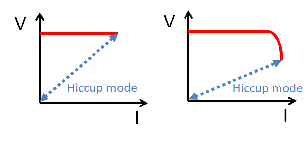Other Parts Discussed in Thread: LM61460
I’d like to know about LM61460-Q1’s behavior for protection from overcurrent.
(1) First let me see if my understanding is correct. My understanding is as follows.
Its behavior employs hiccup mode and that after it detect overcurrent it become stopped state (in other words, both its output current and voltage become 0 [A or V]).
Once it becomes stopped state, it waits for 128 consecutive switching cycles that is about 80 msec. It checks its status buy checking its voltage can be larger than approximately 0.4 times the output voltage set point after that time. If its voltage can be, it becomes standard state.
Is my understanding correct?
(2)Next I would like voltage-current characteristics at hiccup mode. I think its shape is like two attached graphs. Could you show me if LM61460-Q1’s voltage-current characteristics are like left figure or right figure?
In addition, I would like the voltage-current characteristics graph if possible. If not possible, please tell me its rough shape with some values (V, I).


